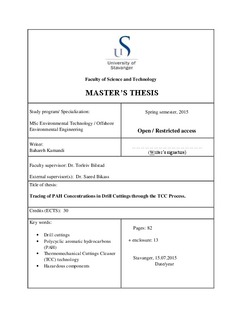| dc.contributor.author | Kamandi, Bahareh | |
| dc.date.accessioned | 2015-09-17T07:46:48Z | |
| dc.date.available | 2015-09-17T07:46:48Z | |
| dc.date.issued | 2015-07-14 | |
| dc.identifier.uri | http://hdl.handle.net/11250/300370 | |
| dc.description | Master's thesis in Enviromental engineering | nb_NO |
| dc.description.abstract | Strict regulations for polycyclic aromatic hydrocarbons (PAH) concentrations in discharged water prompts the oil and gas industry to improve treatment for produced water and drilling fluids which are the main sources of hazardous components such as heavy metals, additives and PAH. The objective of the research was to analyze PAH concentrations before and after TCC treatment in drilling fluids and in recovered substances such as oil, water and solids.
The intention of the research was to determine the presence of 16 hazardous PAH components in drill cuttings before and after the TCC process and to evaluate PAH distribution. Measurement of PAH concentrations and density and weight percentage for cuttings, recovered oil, water and solids was performed. The main method implemented for analysis was gas chromatography (GC) coupled with preparation procedures such as liquid-liquid extraction, solid-liquid extraction, clean-up and up-concentration. TCC was proven to be efficient at removing PAH from cuttings as well as from water. The total PAH removal observed during the research was approximately 87 %. Some PAH components in the recovered solids such as Anthracene, Fluorene and Pyrene, decreased by more than 95 % after TCC, while Methylnaphthalene decreased by 98.38 % and Anthracene by 99.46 %. Concentration of PAH in the recovered water was close to zero and satisfied all the requirements for treated water to be discharged. Some PAH which were not found after the TCC process were assumed to have evaporated during the TCC procedure or followed the sludge. The recovered oil contains most of the PAH which were removed from the drill cuttings during the TCC process. This research proved that the efficiency of the TCC method for drilling fluids treatment is significantly high, providing recovered oil and water of high quality and solids with low oil content. This study can contribute to a better understanding of hazardous components distribution in TCC treatment of oil-based drill cuttings. | nb_NO |
| dc.language.iso | eng | nb_NO |
| dc.publisher | University of Stavanger, Norway | nb_NO |
| dc.relation.ispartofseries | Masteroppgave/UIS-TN-IMN/2015; | |
| dc.subject | teknisk miljøvern | nb_NO |
| dc.subject | drill cuttings | |
| dc.subject | offshore teknologi | |
| dc.title | Tracing of PAH concentration in drill cuttings through the TCC process. | nb_NO |
| dc.type | Master thesis | nb_NO |
| dc.subject.nsi | VDP::Technology: 500::Environmental engineering: 610 | nb_NO |
